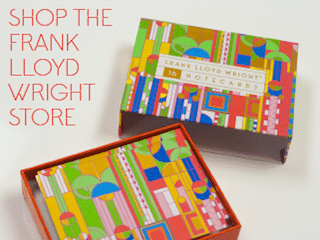
Frank Lloyd Wright Virtual Classroom: Self Portraits & Geometric Form
Frank Lloyd Wright Foundation | Sep 8, 2020
Frank Lloyd Wright was intrigued by nature’s geometric shapes, patterns, and colors and how those elements influenced the way he viewed the world around him and his design work. This activity challenges you to observe the world around you in order to create a geometric self portrait of yourself or someone you know.
Above geometric portrait image of Frank Lloyd Wright: https://dribbble.com/WHAT
Above, left to right:
Pablo Picasso, Self-Portrait, 1907; Andy Warhol, Self-Portait, 1967; Frida Kahlo, Self-Portrait with Necklace, 1933.
Frank Lloyd Wright was highly influenced by nature’s geometric shapes, patterns, and colors. The geometry of the elements inspired how he saw the world around him and how he expressed his design work. In addition, famous artists throughout history like Pablo Picasso, Vincent van Gogh, Frida Kahlo, Paul Gauguin, and Andy Warhol all used geometric shapes and forms to create abstract portraits of themselves.
This self portrait activity asks you to observe the world around you through the lens of abstracted geometric shapes. Try creating a geometric self portrait of yourself or someone you know using geometric, shapes and patterns.
Materials:
-
Picture of yourself or someone else
-
Piece of paper, any size
-
Found materials; aluminum foil, yarn, wire, bubble wrap, fabric, sand, botanical material, feathers, colored paper, or any materials around the house that have become recycled materials.
-
Pencil
-
Scissors
-
Glue
Instructions:
-
Take a picture of yourself on a cell phone or use an old picture of yourself or of someone else.
-
Draw the outline of your portrait on a piece of paper. The paper can be any size you would like. Do not forget to draw in where you would like to put your mouth, nose, and eyes. Remember, it is an abstract picture and it does not have to be perfectly balanced or symmetrical.
-
Make patterns of the geometric shapes you will be using as your cut-outs.
-
As you cut out your geometric shapes, use your imagination and use several types of materials. Put the shapes aside to use when you start to fill in your self portrait.
-
Glue the pieces onto paper within your outline of your portrait. The geometric shapes can overlap but try to keep the outline of your picture.
-
Don’t forget to cut out shapes for the nose, eyes, and mouth.
-
Start creating your self portrait!
-
Send it to us and we will share it on our Facebook page.
Don’t forget to share your projects with us!
Email images of your geometric self portraits from this activity to the Frank Lloyd Wright Foundation’s Education team at: education@franklloydwright.org
The Frank Lloyd Wright Foundation is dedicated to providing quality STEAM education experiences to challenge young people around the world to be critical thinkers and creative problem solvers. During this uncertain time, with families around the world keeping their kids engaged in learning activities, the Foundation is proud to offer these lessons and other activities free of charge. Your support helps the Frank Lloyd Wright Foundation keep their staff employed and creating education programs at this critical time, and long into the future.
Support these education programs and the work of the Frank Lloyd Wright Foundation.



